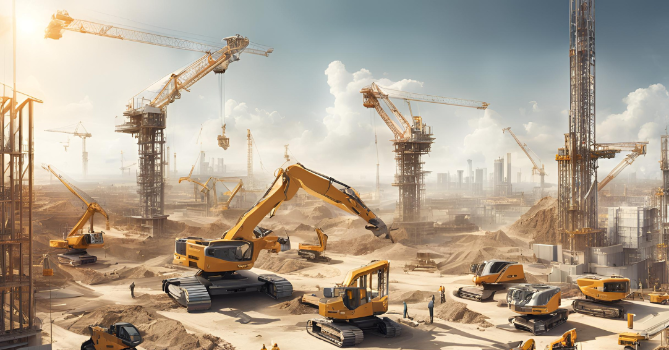.png)
Robotics and Automation in Construction: How BIM Facilitates Integration
Introduction to Robotics and Automation in Construction
Robotics and automation are reshaping construction as we know it. As the industry faces labor shortages and increasing demands, automation is becoming essential. Robots and automated systems can take on repetitive tasks, making work sites safer and more efficient. These tools help meet deadlines faster, with fewer errors, and require less human involvement in hazardous areas.
The impact is impressive. From robots laying bricks to drones surveying large areas, robotics is improving accuracy and speed in construction. Recent reports show that using robotics can boost productivity by up to 30%, which is crucial as demand continues to grow. Industry experts agree that robotics, powered by automation, will be a game-changer for construction. By reducing reliance on human labor and increasing precision, robotics is meeting the industry’s need for safer, faster, and smarter solutions.
The Role of BIM in Robotics and Automation
Building Information Modeling (BIM) is the bridge between robotics and construction. Acting as a central hub, BIM brings all project data together in a clear, visual format that robotics can rely on for precise operations. With BIM, construction teams can plan robotic tasks with detailed accuracy, allowing robots to work from exact blueprints. This seamless data flow means robots can navigate complex tasks with confidence and minimal errors.

One of BIM’s strengths is its ability to visualize every detail of a construction project in 3D. These visuals help robots “see” the layout, materials, and sequences needed to perform each task. For example, using BIM data, robots can measure spaces, avoid obstacles, and adjust to changes without pausing for human input. This improves efficiency and keeps the project on track.
Studies and real-world projects demonstrate BIM’s role in successful robotic deployment. In a recent project, teams using BIM-guided robots finished 25% faster than projects without BIM support. Another case study showed a sharp drop in errors when BIM was used to plan and guide robotic machinery. By combining BIM with automation, construction teams can count on smoother workflows, better accuracy, and faster completion rates.
Benefits of BIM-Driven Robotics Integration
Integrating BIM with robotics has unlocked a range of benefits for construction, from boosting productivity to making sites safer. BIM-driven robotics allow for precise, data-backed planning, which leads to faster work and fewer mistakes. With accurate data at their fingertips, robots can execute tasks efficiently and consistently, reducing the need for rework and helping teams stay on schedule.

One of the standout benefits is time efficiency. BIM helps robots move seamlessly from one task to another, with minimal setup or downtime. This efficiency can reduce overall project timelines by as much as 20%. Additionally, cost reduction is another significant benefit. By cutting down errors and waste, BIM-driven robots can lower material costs and reduce labor hours. These cost savings add up, helping companies stay within budget without compromising on quality.
Real-world examples highlight these advantages. In one project, a robotics team using BIM completed a multi-story framework in just half the usual time, setting a new standard for speed. Similarly, a bridge construction project used BIM-guided robots for precise assembly, reducing human error and ensuring the bridge was built to exact specifications. The result was a safer, stronger structure with fewer post-construction adjustments needed.

Statistics back up these outcomes. A study showed that construction sites using BIM-driven robotics saw a 25% reduction in labor costs and a 30% increase in productivity. Moreover, safety improved as robots took over high-risk tasks, keeping workers out of potentially dangerous situations. With BIM, robotics integration is not just a trend but a powerful tool transforming how construction projects are completed, offering unmatched benefits in speed, accuracy, and safety.
Overcoming Integration Challenges
Integrating robotics with BIM isn't without challenges. One of the main hurdles is data interoperability. Different robots and software often work with various data formats, making it difficult for systems to communicate seamlessly. This lack of standardization can cause delays and errors on-site, reducing the efficiency of automation.
Another common issue is real-time coordination. Construction projects are dynamic, and robots need up-to-date data to respond accurately. Without reliable, real-time information, robots can struggle to adjust to changes, risking errors or disruptions in the workflow.

Fortunately, solutions are emerging. Standardizing data formats across platforms helps improve compatibility, ensuring that all systems can work together smoothly. Enhanced data-sharing protocols allow for seamless updates, keeping robots informed of any changes on-site. For instance, using cloud-based BIM platforms lets teams share live data across all devices, providing robots with real-time instructions.
Industry experts agree that addressing these integration challenges is essential for maximizing the potential of robotics in construction. According to recent studies, projects that implemented standardized data-sharing protocols saw a 15% increase in efficiency. Overcoming these barriers doesn’t just streamline operations; it also opens up possibilities for even more advanced automation in the future, setting the stage for smarter, faster construction.
The Future of Robotics and BIM in Construction
The future of construction lies in the growing synergy between BIM and robotics. As both technologies advance, new trends are emerging, such as AI-powered BIM systems capable of predictive maintenance. These systems will allow robots to detect and address issues before they become costly problems, keeping projects on schedule and within budget.

In the near future, we may see BIM and robotics working autonomously on complex tasks like assembling structures or monitoring site safety without constant human intervention. This level of automation could cut down project timelines and costs significantly.
Experts predict a strong ROI for companies that embrace these advancements. Studies show that firms adopting BIM-driven automation could see a 30% boost in productivity and up to 20% in cost savings. By combining BIM’s precision with robotics’ efficiency, the construction industry is heading towards a future where projects are faster, safer, and smarter than ever.
Conclusion
Robotics and BIM are transforming construction, bringing unmatched precision, speed, and safety to projects. By integrating these technologies, companies can reduce costs, improve productivity, and minimize errors, setting new industry standards. As data shows, firms that adopt BIM-driven automation gain a significant competitive edge, boosting efficiency and profitability. Embracing these tools isn’t just a choice; it’s the path forward in a rapidly advancing industry. With BIM and robotics shaping the future, now is the time for construction leaders to invest in smarter, faster, and safer solutions that align with industry trends and demands.